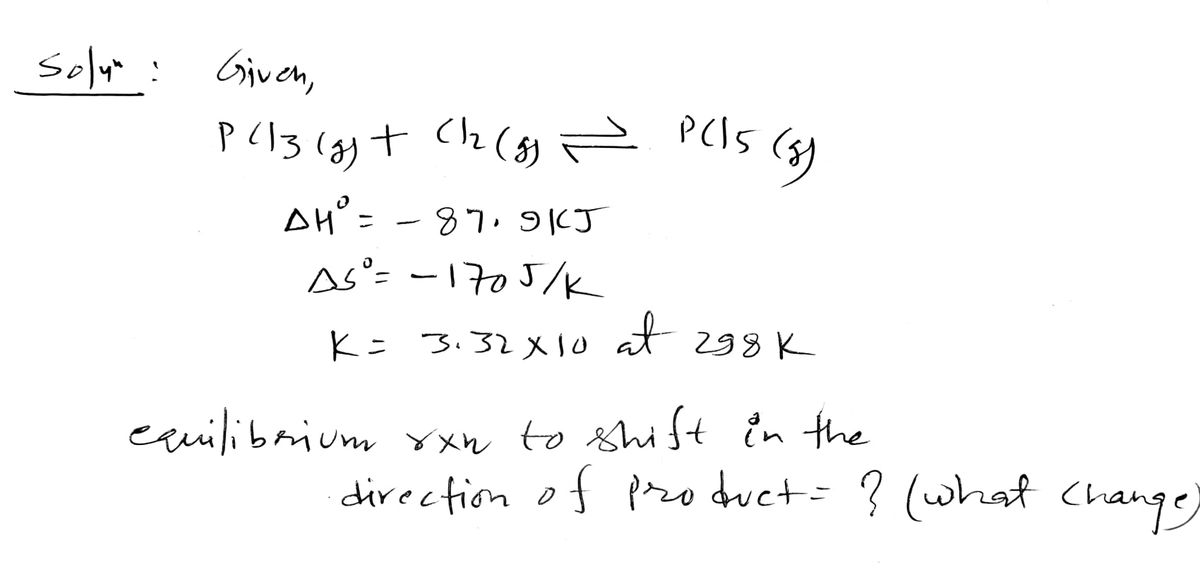The reaction PC13(g) + Cl₂(g) = PC15(g) has AH = -87.9 kJ, AS° = -170 J/K, K = 3.32 x 10 at 298 K. Which change of conditions causes this equilibrium reaction to shift in the direction of product? Doubling all pressures by halving the volume of the reaction vessel. Adding a catalyst that accelerates the reaction rates. Increasing the temperature. O Doubling the pressure by adding Ar(g).
The reaction PC13(g) + Cl₂(g) = PC15(g) has AH = -87.9 kJ, AS° = -170 J/K, K = 3.32 x 10 at 298 K. Which change of conditions causes this equilibrium reaction to shift in the direction of product? Doubling all pressures by halving the volume of the reaction vessel. Adding a catalyst that accelerates the reaction rates. Increasing the temperature. O Doubling the pressure by adding Ar(g).
Chemistry
10th Edition
ISBN:9781305957404
Author:Steven S. Zumdahl, Susan A. Zumdahl, Donald J. DeCoste
Publisher:Steven S. Zumdahl, Susan A. Zumdahl, Donald J. DeCoste
Chapter1: Chemical Foundations
Section: Chapter Questions
Problem 1RQ: Define and explain the differences between the following terms. a. law and theory b. theory and...
Related questions
Question
100%
![The reaction
\[ \text{PCl}_3(\text{g}) + \text{Cl}_2(\text{g}) \rightleftharpoons \text{PCl}_5(\text{g}) \]
has \( \Delta H^\circ = -87.9 \, \text{kJ} \), \( \Delta S^\circ = -170 \, \text{J/K} \), \( K = 3.32 \times 10 \) at 298 K. Which change of conditions causes this equilibrium reaction to shift in the direction of product?
- Doubling all pressures by halving the volume of the reaction vessel.
- Adding a catalyst that accelerates the reaction rates.
- Increasing the temperature.
- Doubling the pressure by adding Ar(g).](/v2/_next/image?url=https%3A%2F%2Fcontent.bartleby.com%2Fqna-images%2Fquestion%2Fa6a0f832-4e15-4e0c-a69c-19f69479850e%2F930e3dba-55cc-4581-a79b-749c32fae6e0%2Fxi3pxgs_processed.jpeg&w=3840&q=75)
Transcribed Image Text:The reaction
\[ \text{PCl}_3(\text{g}) + \text{Cl}_2(\text{g}) \rightleftharpoons \text{PCl}_5(\text{g}) \]
has \( \Delta H^\circ = -87.9 \, \text{kJ} \), \( \Delta S^\circ = -170 \, \text{J/K} \), \( K = 3.32 \times 10 \) at 298 K. Which change of conditions causes this equilibrium reaction to shift in the direction of product?
- Doubling all pressures by halving the volume of the reaction vessel.
- Adding a catalyst that accelerates the reaction rates.
- Increasing the temperature.
- Doubling the pressure by adding Ar(g).
Expert Solution
Step 1

Step by step
Solved in 2 steps with 2 images

Knowledge Booster
Learn more about
Need a deep-dive on the concept behind this application? Look no further. Learn more about this topic, chemistry and related others by exploring similar questions and additional content below.Recommended textbooks for you

Chemistry
Chemistry
ISBN:
9781305957404
Author:
Steven S. Zumdahl, Susan A. Zumdahl, Donald J. DeCoste
Publisher:
Cengage Learning

Chemistry
Chemistry
ISBN:
9781259911156
Author:
Raymond Chang Dr., Jason Overby Professor
Publisher:
McGraw-Hill Education

Principles of Instrumental Analysis
Chemistry
ISBN:
9781305577213
Author:
Douglas A. Skoog, F. James Holler, Stanley R. Crouch
Publisher:
Cengage Learning

Chemistry
Chemistry
ISBN:
9781305957404
Author:
Steven S. Zumdahl, Susan A. Zumdahl, Donald J. DeCoste
Publisher:
Cengage Learning

Chemistry
Chemistry
ISBN:
9781259911156
Author:
Raymond Chang Dr., Jason Overby Professor
Publisher:
McGraw-Hill Education

Principles of Instrumental Analysis
Chemistry
ISBN:
9781305577213
Author:
Douglas A. Skoog, F. James Holler, Stanley R. Crouch
Publisher:
Cengage Learning

Organic Chemistry
Chemistry
ISBN:
9780078021558
Author:
Janice Gorzynski Smith Dr.
Publisher:
McGraw-Hill Education

Chemistry: Principles and Reactions
Chemistry
ISBN:
9781305079373
Author:
William L. Masterton, Cecile N. Hurley
Publisher:
Cengage Learning

Elementary Principles of Chemical Processes, Bind…
Chemistry
ISBN:
9781118431221
Author:
Richard M. Felder, Ronald W. Rousseau, Lisa G. Bullard
Publisher:
WILEY